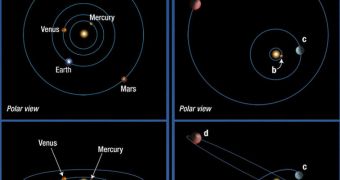One of the things that has remained the same about exoplanetary studies is the fact that astronomers always assume that a planet's orbit has remained the same for a long time. In most cases, this really happened, but in other instance it's far from it, scientists say. Recent studies on the influence gas giant-like objects have on inner planets in extrasolar systems have revealed that gravitational interactions may easily change the orbits of the smaller planets. The new study therefore implies that certain, smaller exoplanets may be habitable only at times, Space reports.
Even in our own planetary system, bodies such as Saturn and Jupiter could easily exert major influences on the orbits of Earth, Mars, Venus and Mercury, throwing them about, and forcing their paths around the Sun to shift drastically over time. When applied to our planet, this scenario implies that the already-slim chances of life ever appearing would have been diminished further. If Earth were to have been bounced around like a spec of dust by interacting gravitational forces, then life may have never developed to the point it's at today, scientists believe.
“There is this crazy zoo of planets out there that probably are habitable, but their properties are very different from Earth and they're different from Earth because of their eccentric neighbors,” explains University of Washington expert Rory Barnes, who is also a member of the research team that conducted the investigation. Two new studies detailing this idea were presented yesterday in Miami, at the 216th meeting of the American Astronomical Society (AAS 2010)."
“The findings mean that future studies of exoplanetary systems will be more complicated. Astronomers can no longer assume all planets orbit their parent star in a single plane,” said University of Texas in Austin expert Barbara McArthur. She was the lead researcher on one of the two papers presented at the conference. The scientist gives the example of a star system she and her team recently found, that features two planets orbiting their parent star at a very steep angle when compared to each other.
The experts also spoke about how an exoplanet taken off its orbit could support life. They said that, for parts of the time, an Earth-sized object may be able to sustain life, but that it may lose this ability over time, or even within the same one orbit around its parent star (one year). “There could be planets out there that have their geological properties change over very long timescales. You can imagine planets that cycle in and out of intense volcanism and earthquake stages. The length of the day changes almost day to day. It's fascinating to think about how evolution occurs on such a world,” said Barnes.

 14 DAY TRIAL //
14 DAY TRIAL //